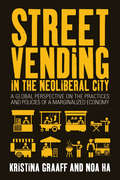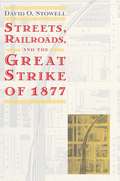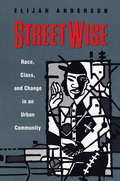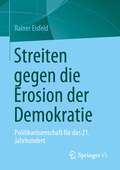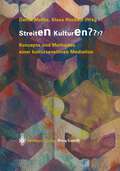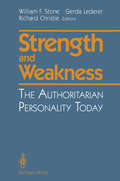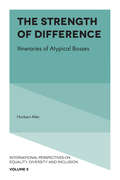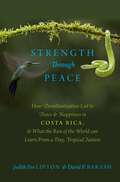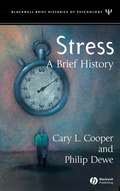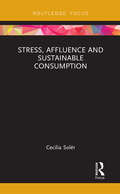- Table View
- List View
Street Vending in the Neoliberal City: A Global Perspective on the Practices and Policies of a Marginalized Economy
by Kristina Graaff and Noa HaExamining street vending as a global, urban, and informalized practice found both in the Global North and Global South, this volume presents contributions from international scholars working in cities as diverse as Berlin, Dhaka, New York City, Los Angeles, Calcutta, Rio de Janeiro, and Mexico City. The aim of this global approach is to repudiate the assumption that street vending is usually carried out in the Southern hemisphere and to reveal how it also represents an essential—and constantly growing—economic practice in urban centers of the Global North. Although street vending activities vary due to local specificities, this anthology illustrates how these urban practices can also reveal global ties and developments.
Streets, Railroads, and the Great Strike of 1877 (Historical Studies of Urban America)
by David O. StowellFor one week in late July of 1877, America shook with anger and fear as a variety of urban residents, mostly working class, attacked railroad property in dozens of towns and cities. The Great Strike of 1877 was one of the largest and most violent urban uprisings in American history. Whereas most historians treat the event solely as a massive labor strike that targeted the railroads, David O. Stowell examines America's predicament more broadly to uncover the roots of this rebellion. He studies the urban origins of the Strike in three upstate New York cities—Buffalo, Albany, and Syracuse. He finds that locomotives rumbled through crowded urban spaces, sending panicked horses and their wagons careening through streets. Hundreds of people were killed and injured with appalling regularity. The trains also disrupted street traffic and obstructed certain forms of commerce. For these reasons, Stowell argues, The Great Strike was not simply an uprising fueled by disgruntled workers. Rather, it was a grave reflection of one of the most direct and damaging ways many people experienced the Industrial Revolution. "Through meticulously crafted case studies . . . the author advances the thesis that the strike had urban roots, that in substantial part it represented a community uprising. . . .A particular strength of the book is Stowell's description of the horrendous accidents, the toll in human life, and the continual disruption of craft, business, and ordinary movement engendered by building railroads into the heart of cities."—Charles N. Glaab, American Historical Review
Streetwise: Race, Class, and Change in an Urban Community
by Elijah AndersonIn a powerful, revealing portrait of city life, Anderson explores the dilemma of both blacks and whites, the underclass and the middle class, caught up in the new struggle not only for common ground—prime real estate in a racially changing neighborhood—but for shared moral community. Blacks and whites from a variety of backgrounds speak candidly about their lives, their differences, and their battle for viable communities. "The sharpness of his observations and the simple clarity of his prose recommend his book far beyond an academic audience. Vivid, unflinching, finely observed, Streetwise is a powerful and intensely frightening picture of the inner city."—Tamar Jacoby, New York Times Book Review "The book is without peer in the urban sociology literature. . . . A first-rate piece of social science, and a very good read."—Glenn C. Loury, Washington Times
Streetwise: Race, Class, and Change in an Urban Community
by Elijah AndersonIn a powerful, revealing portrait of city life, Anderson explores the dilemma of both blacks and whites, the underclass and the middle class, caught up in the new struggle not only for common ground—prime real estate in a racially changing neighborhood—but for shared moral community. Blacks and whites from a variety of backgrounds speak candidly about their lives, their differences, and their battle for viable communities. "The sharpness of his observations and the simple clarity of his prose recommend his book far beyond an academic audience. Vivid, unflinching, finely observed, Streetwise is a powerful and intensely frightening picture of the inner city."—Tamar Jacoby, New York Times Book Review "The book is without peer in the urban sociology literature. . . . A first-rate piece of social science, and a very good read."—Glenn C. Loury, Washington Times
Streetwise: Race, Class, and Change in an Urban Community
by Elijah AndersonIn a powerful, revealing portrait of city life, Anderson explores the dilemma of both blacks and whites, the underclass and the middle class, caught up in the new struggle not only for common ground—prime real estate in a racially changing neighborhood—but for shared moral community. Blacks and whites from a variety of backgrounds speak candidly about their lives, their differences, and their battle for viable communities. "The sharpness of his observations and the simple clarity of his prose recommend his book far beyond an academic audience. Vivid, unflinching, finely observed, Streetwise is a powerful and intensely frightening picture of the inner city."—Tamar Jacoby, New York Times Book Review "The book is without peer in the urban sociology literature. . . . A first-rate piece of social science, and a very good read."—Glenn C. Loury, Washington Times
Streetwise: Race, Class, and Change in an Urban Community
by Elijah AndersonIn a powerful, revealing portrait of city life, Anderson explores the dilemma of both blacks and whites, the underclass and the middle class, caught up in the new struggle not only for common ground—prime real estate in a racially changing neighborhood—but for shared moral community. Blacks and whites from a variety of backgrounds speak candidly about their lives, their differences, and their battle for viable communities. "The sharpness of his observations and the simple clarity of his prose recommend his book far beyond an academic audience. Vivid, unflinching, finely observed, Streetwise is a powerful and intensely frightening picture of the inner city."—Tamar Jacoby, New York Times Book Review "The book is without peer in the urban sociology literature. . . . A first-rate piece of social science, and a very good read."—Glenn C. Loury, Washington Times
Streetwise: Race, Class, and Change in an Urban Community
by Elijah AndersonIn a powerful, revealing portrait of city life, Anderson explores the dilemma of both blacks and whites, the underclass and the middle class, caught up in the new struggle not only for common ground—prime real estate in a racially changing neighborhood—but for shared moral community. Blacks and whites from a variety of backgrounds speak candidly about their lives, their differences, and their battle for viable communities. "The sharpness of his observations and the simple clarity of his prose recommend his book far beyond an academic audience. Vivid, unflinching, finely observed, Streetwise is a powerful and intensely frightening picture of the inner city."—Tamar Jacoby, New York Times Book Review "The book is without peer in the urban sociology literature. . . . A first-rate piece of social science, and a very good read."—Glenn C. Loury, Washington Times
Streetwise: Race, Class, and Change in an Urban Community
by Elijah AndersonIn a powerful, revealing portrait of city life, Anderson explores the dilemma of both blacks and whites, the underclass and the middle class, caught up in the new struggle not only for common ground—prime real estate in a racially changing neighborhood—but for shared moral community. Blacks and whites from a variety of backgrounds speak candidly about their lives, their differences, and their battle for viable communities. "The sharpness of his observations and the simple clarity of his prose recommend his book far beyond an academic audience. Vivid, unflinching, finely observed, Streetwise is a powerful and intensely frightening picture of the inner city."—Tamar Jacoby, New York Times Book Review "The book is without peer in the urban sociology literature. . . . A first-rate piece of social science, and a very good read."—Glenn C. Loury, Washington Times
Streik im Wandel (essentials)
by Irene RaehlmannIm Zentrum des essentials stehen die aktuellen Streiks von 2014/15, die in verschiedenen Branchen des Dienstleistungssektors stattgefunden haben, so bei der Bahn, der Lufthansa, der Post und den Kitas. Die Autorin verdeutlicht in ihrer Schrift den prägnanten Unterschied dieser Streiks zu denjenigen in der Industrie. Bei Ersteren ist nicht nur das bestreikte Unternehmen betroffen, sondern unmittelbar die Gesellschaft insgesamt und vor allem die BürgerInnen: Sie müssen den in Unordnung geratenen Alltag neu ordnen, was besonders für Erwerbstätige eine enorme Herausforderung bedeutet.
Streiten auf Distanz!?: Transstaatliche Familienpraxis in soziotechnischen Konstellationen (Kulturen der Gesellschaft #55)
by Jagoda MotowidloWenn transstaatlich organisierte Familien streiten, dann meist medial vermittelt. Doch wie streiten Eltern und Kinder, wenn die Technik den Rahmen vorgibt? Wie übersetzen sie ihr medial vermitteltes Miteinander wieder in körperliche Kopräsenz? Jagoda Motowidlo fokussiert mit mikrosoziologischen Einblicken das Konfliktgeschehen transstaatlicher Familien, in welchem sowohl die Eigenlogiken familialer Praktiken als auch jene des technischen Rahmens miteinander in Wechselwirkung treten. Ihre Analyse zeigt dabei Phänomene wie neue Präsenzverständnisse, soziale Deutungen technischer Störungen und eine Verteilung von Handlungsträgerschaften auf mehr als nur menschliche Instanzen auf.
Streiten gegen die Erosion der Demokratie: Politikwissenschaft für das 21. Jahrhundert
by Rainer EisfeldEuropaweit und darüber hinaus unterliegen Demokratien alarmierender Aushöhlung. Rapider wirtschaftlicher, kultureller, politischer Wandel weckt Unsicherheiten und Aggressionen; Politiker, Parteien, selbst Regierungen versuchen Bürger durch systematische Lügen zu täuschen; neoliberale Deregulierungen schwächen die Bereitschaft zum zivilgesellschaftlichen Engagement; schroffe Einkommens- und Vermögensunterschiede treiben die Demokratie in Richtung Plutokratie; fremdenfeindliche Vorurteile polarisieren Gesellschaften; Antiterrorismus-Strategien untergraben bürgerliche Freiheiten; Vetospieler hemmen klimapolitischen Wandel. Zugleich wird seit Jahren gestritten über die Fragmentierung der Politikwissenschaft, ihre zweifelhafte Relevanz und ihre Abkopplung von der breiten Öffentlichkeit. Dieses Buch ist die erste umfassende Studie, die beide Fragenkomplexe miteinander verknüpft und präzise zu ergründen sucht: Wie kann, wie sollte die Politikwissenschaft dem Niedergang der Demokratie in jedem der erwähnten Bereiche entgegenwirken?Rainer Eisfelds Antworten lauten: Entwicklung einer Wissenschaftskultur öffentlichen Engagements; Auseinandersetzung mit Ursprüngen, Mustern und partizipativer Bewältigung durchgängigen Wandels als Hauptgegenstand der Disziplin; kategorisches Auftreten gegen Tendenzen zu einer Herrschaft notorischer Lügner; Konzentrierung der Forschungsprioritäten auf die Schlüsselbereiche, in denen Demokratie sich zurückbildet; für Laien zugängliche Darstellung gewonnener Resultate; Erweiterung der Analyse zur Präsentation konkreter Gestaltungsvorschläge.Dazu, so Eisfelds Fazit, bedarf es einer Disziplin, die als normativ orientierte, empirisch gestützte Demokratiewissenschaft brisanten Problemen den Vorrang einräumt vor ausgefeilten Methoden und bürgernaher Relevanz vor immer weiterer Spezialisierung.
Streiten Kulturen?: Konzepte und Methoden einer kultursensitiven Mediation
by Gerda Mehta Klaus RückertKultur und Herkunft, Tradition und Geschichte, soziales Denken und individualistische Züge prägen Menschen. Sie formen auch ihre Neigungen zu Auseinandersetzung, ihre Streitstile, ihre Toleranz und Flexibilität sowie ihre Motivation zu streiten, miteinander auszukommen und Feindschaften oder Ärgernisse überwinden zu wollen. In diesem Buch zeigen AutorInnen anhand zahlreicher praktischer Beispiele auf, wie mit Hilfe von Mediation zufriedenstellende Lösungen für ein konstruktives Miteinander erreicht werden können. Neben dem theoretischen Hintergrund von interkultureller Konfliktregelung werden methodische Besonderheiten, wie etwa Techniken aus dem Improvisationstheater, Rollenspiele und typische Anwendungsfelder, z.B. die Schule und deren kulturelles Konfliktpotential, praxisrelevant aufbereitet. Das Buch bietet somit einen guten Überblick zur interkulturellen Mediation und ist daher unverzichtbar für alle, die mit Menschen unterschiedlicher Kultur arbeiten.
Streitfall Natur: Weltbilder in Technik- und Umweltkonflikten
by Bernhard GillIn Technik- und Umweltkonflikten geht es nicht so sehr um besseres oder schlechteres Wissen - wie die meisten Naturwissenschaftler glauben. Auch nicht um Interessen oder Risiken - wie die meisten Sozialwissenschaftler annehmen. Motiviert ist der vordergründige Streit um Wissen, Risiken und Interessen durch unterschiedliche Weltbilder: Konservative Identitätsorientierung, utilitaristische Fortschrittsorientierung und romantische Alteritätsorientierung stehen hier gegeneinander. Diese Typologie der Weltbilder und Naturvorstellungen wird ideengeschichtlich rekonstruiert und zur Interpretation aktueller Konflikte um die Gen- und Biotechnologie herangezogen.
Strength and Weakness: The Authoritarian Personality Today
by RichardChristie GerdaLederer William F. StoneThis book had its origins in conversations held at various meetings of the International Society of Political Psychology. The editors and con tributors are grateful for the forum that has given us the opportunity to discuss these topics over the last 10 years. We are most grateful to our contributors both for their chapters and for the intellectual stimulation they have given us. Jos Meloen in particular has been free with his time, advice, and enthusiasm. Although he declined to contribute a chapter, Bob Altemeyer has been a source of encouragement and a ready adviser on any question we have asked. The staff of Springer-Verlag has been most patient in adapting to our schedule. We are indebted to the secretarial staff at the University of Maine, and especially to Kathy McAuliffe, who has put in many extra hours above and beyond the call of duty. Finally, we dedicate this book to our departed friend and colleague, Silvan Tomkins, with whom we conversed at length about these and other topics, and from whom we received inspiration and diversion. William F. Stone Gerda Lederer Richard Christie v Contents Preface. . . .. . . . . . . . . .. . . . . . . . . . . . . . . . . .. . . . . . . . . . . . . . . .. . . . . v Contributors. . . . . . . . . . . . . . . . . . . . . . . . . . . . . . . . . . ix . . . . . . . . . . . . . . . Part I Overview 1 Introduction: Strength and Weakness ........................ 3 WILLIAM F. STONE, GERDA LEDERER, and RICHARD CHRISTIE 2 The Authoritarian Character from Berlin to Berkeley and Beyond: The Odyssey of a Problem. . . . . . . . . . . . . . . . . .. . . 22 . . . . . .
Strength-Based Lean Six Sigma: Building Positive and Engaging Business Improvement
by David ShakedStrength-based Lean Six Sigma is a new way of approaching process improvement that combines the best practices of two established methodologies to generate a new approach in order to help you develop and deliver increased high performance in any organization. It is the first book to use approaches in business improvement as well as organizational change for optimum organizational performance and improved agility.Combining the energy and motivation released through a strengths-based approach with the focus on quality and efficiency generated by lean six sigma, it offers practitioners from all disciplines the opportunity to understand each other and work successfully together to drive effective and powerful change programmes.
Strength-Based Lean Six Sigma: Building Positive and Engaging Business Improvement
by David ShakedStrength-based Lean Six Sigma is a new way of approaching process improvement that combines the best practices of two established methodologies to generate a new approach in order to help you develop and deliver increased high performance in any organization. It is the first book to use approaches in business improvement as well as organizational change for optimum organizational performance and improved agility.Combining the energy and motivation released through a strengths-based approach with the focus on quality and efficiency generated by lean six sigma, it offers practitioners from all disciplines the opportunity to understand each other and work successfully together to drive effective and powerful change programmes.
The Strength of Difference: Itineraries of Atypical Bosses (International Perspectives on Equality, Diversity and Inclusion #5)
by Norbert AlterBosses and managers from atypical backgrounds have succeeded in avoiding socially pre-determined outcomes by turning their differences into resources. This did not, however, mean that they became "normal". They are leaders, but they remain excluded from convened social positions.This distance leads them to listen, to look upon, and to analyse their environments, their pasts and their relations with others much more than "normal" people do. Furthermore, this distance facilitates entrepreneurial risk-taking and the creation of networks, complicity and solidarity. It requires the mobilization of extraordinary social intelligence. This book describes the processes through which stigma can be mastered, if not forgotten. It also explains that the position of outsiders, in the broadest meaning of the term, translates the social experiences of all those who belong to several worlds, and who find themselves condemned simultaneously to engagement and detachment.
The Strength of Difference: Itineraries of Atypical Bosses (International Perspectives on Equality, Diversity and Inclusion #5)
by Norbert AlterBosses and managers from atypical backgrounds have succeeded in avoiding socially pre-determined outcomes by turning their differences into resources. This did not, however, mean that they became "normal". They are leaders, but they remain excluded from convened social positions.This distance leads them to listen, to look upon, and to analyse their environments, their pasts and their relations with others much more than "normal" people do. Furthermore, this distance facilitates entrepreneurial risk-taking and the creation of networks, complicity and solidarity. It requires the mobilization of extraordinary social intelligence. This book describes the processes through which stigma can be mastered, if not forgotten. It also explains that the position of outsiders, in the broadest meaning of the term, translates the social experiences of all those who belong to several worlds, and who find themselves condemned simultaneously to engagement and detachment.
Strength Through Peace: How Demilitarization Led to Peace and Happiness in Costa Rica, and What the Rest of the World can Learn From a Tiny, Tropical Nation
by David P. Barash Judith Eve LiptonCosta Rica is the only full-fledged and totally independent country to be entirely demilitarized. Its military was abolished in 1948, with the keys to the armory handed to the Department of Education. Socially, Costa Rica is a success story. Although 94th in the world for GDP, it is in the top 10 on various measurements of health and well-being. Citizens enjoy high standards of living that include universal access to healthcare, education, and pensions. In addition, the country practices sustainable resource management, such as reforestation and the development of solar and wind power, and it expects to be carbon neutral by 2020. Hunting is illegal. 25% of the landmass is parks and reserves. The government supports universal health care, especially maternal and child health. Costa Rica even has a Blue Zone, an area where people live extraordinarily long, healthy lives. To some extent, Costa Rica is simply lucky: it was largely inaccessible, and it had virtually no precious minerals, therefore it was mostly spared the ravages of predatory colonialism. The Costa Rican people made very good social decisions, ranging from an avowed commitment to social democracy at the national level, to local land distribution to develop stable middle class farmers. But Costa Rica's neighbors have not enjoyed nearly as much peace and prosperity. It is unlikely that Costa Rica's demilitarization and its remarkable social success are coincidental; clearly, something special is going on. Through good luck, good leadership, and good decisions, Costa Rica has become arguably the sanest and most progressive country on earth. This book examines how and why Costa Rica is safe and independent without any military at all, and what the rest of us can learn from its success.
Strength Through Peace: How Demilitarization Led to Peace and Happiness in Costa Rica, and What the Rest of the World can Learn From a Tiny, Tropical Nation
by Judith Eve Lipton David P. BarashCosta Rica is the only full-fledged and totally independent country to be entirely demilitarized. Its military was abolished in 1948, with the keys to the armory handed to the Department of Education. Socially, Costa Rica is a success story. Although 94th in the world for GDP, it is in the top 10 on various measurements of health and well-being. Citizens enjoy high standards of living that include universal access to healthcare, education, and pensions. In addition, the country practices sustainable resource management, such as reforestation and the development of solar and wind power, and it expects to be carbon neutral by 2020. Hunting is illegal. 25% of the landmass is parks and reserves. The government supports universal health care, especially maternal and child health. Costa Rica even has a Blue Zone, an area where people live extraordinarily long, healthy lives. To some extent, Costa Rica is simply lucky: it was largely inaccessible, and it had virtually no precious minerals, therefore it was mostly spared the ravages of predatory colonialism. The Costa Rican people made very good social decisions, ranging from an avowed commitment to social democracy at the national level, to local land distribution to develop stable middle class farmers. But Costa Rica's neighbors have not enjoyed nearly as much peace and prosperity. It is unlikely that Costa Rica's demilitarization and its remarkable social success are coincidental; clearly, something special is going on. Through good luck, good leadership, and good decisions, Costa Rica has become arguably the sanest and most progressive country on earth. This book examines how and why Costa Rica is safe and independent without any military at all, and what the rest of us can learn from its success.
Strengthening Families, Communities, and Schools to Support Children's Development: Neighborhoods of Promise
by Edmund W. Gordon Betina Jean-Louis Nkechi ObioraDrawing on a range of contexts influenced by the Promise Neighborhoods Program—a federal place-based initiative to improve educational outcomes for students in distressed urban and rural neighborhoods—this book outlines effective characteristics and elements for implementing supplementary education. Chapter authors demonstrate that the disparities in educational achievement between white and non-white students can only be addressed by a holistic approach that takes the communities in which schools are situated as its focal point. This edited collection distills the insights gained from the communities implementing such comprehensive education programs and provides the framework and models for reproducing such successes.
Strengthening Families, Communities, and Schools to Support Children's Development: Neighborhoods of Promise
by Edmund W. Gordon Betina Jean-Louis Nkechi ObioraDrawing on a range of contexts influenced by the Promise Neighborhoods Program—a federal place-based initiative to improve educational outcomes for students in distressed urban and rural neighborhoods—this book outlines effective characteristics and elements for implementing supplementary education. Chapter authors demonstrate that the disparities in educational achievement between white and non-white students can only be addressed by a holistic approach that takes the communities in which schools are situated as its focal point. This edited collection distills the insights gained from the communities implementing such comprehensive education programs and provides the framework and models for reproducing such successes.
Stress: A Brief History (Blackwell Brief Histories of Psychology)
by Cary Cooper Philip J. DeweStress: A Brief History is a lively, accessible, and detailed examination of the origins of the field of stress research. First concise, accessible, academically grounded book on the origins of the concept of stress. Explores different theories and models of stress such as the psychosomatic approach, homeostasis, and general adaptation syndrome. Discusses the work and intriguing contributions of key researchers in the field such as Walter Cannon, Hans Selye, Harold Wolff, and Richard Lazarus. Explains the origins of key concepts in stress such as stressful life events, the coronary-prone personality, and appraisals and coping. Culminates in a discussion of what makes a good theory and what obligations stress researchers have to those whose working lives they study.
Stress, Affluence and Sustainable Consumption (Routledge Studies in Sustainability)
by Cecilia SolérWhy do affluent consumers almost automatically acquire new versions or variations of products already at their disposal? Even though most of us know that this novelty consumption poses a serious threat to an environmentally and socially sustainable future, we continue to do it. Why? Research shows that consumption of new automobiles, clothing, furniture, electronics, home furnishing, household apparel, mobile phones, etc., is motivated by a desire to feel more secure, less anxious and better mood-wise. Affluent consumers seem to engage in novelty consumption not to feel better but rather to avoid feeling bad. Stress, Affluence and Sustainable Consumption discusses sustainable consumption from a stress perspective, adding an embodied understanding to the sustainability-related consumption challenges that we face today. A stress perspective on affluent consumption differs from current understandings on consumption, as it fully acknowledges the consumer as having a body (including a mind) that reacts to the numerous product offerings and retail spaces, both physical and online. A stress perspective can explain how our bodies try to cope with an overload of perceptual input provided by advertising messages, product launches and even store structures. This book will be of great interest to students and researchers of consumer psychology, sustainable consumption studies, sustainable marketing and markets as well as sustainable development more generally.
Stress, Affluence and Sustainable Consumption (Routledge Studies in Sustainability)
by Cecilia SolérWhy do affluent consumers almost automatically acquire new versions or variations of products already at their disposal? Even though most of us know that this novelty consumption poses a serious threat to an environmentally and socially sustainable future, we continue to do it. Why? Research shows that consumption of new automobiles, clothing, furniture, electronics, home furnishing, household apparel, mobile phones, etc., is motivated by a desire to feel more secure, less anxious and better mood-wise. Affluent consumers seem to engage in novelty consumption not to feel better but rather to avoid feeling bad. Stress, Affluence and Sustainable Consumption discusses sustainable consumption from a stress perspective, adding an embodied understanding to the sustainability-related consumption challenges that we face today. A stress perspective on affluent consumption differs from current understandings on consumption, as it fully acknowledges the consumer as having a body (including a mind) that reacts to the numerous product offerings and retail spaces, both physical and online. A stress perspective can explain how our bodies try to cope with an overload of perceptual input provided by advertising messages, product launches and even store structures. This book will be of great interest to students and researchers of consumer psychology, sustainable consumption studies, sustainable marketing and markets as well as sustainable development more generally.
